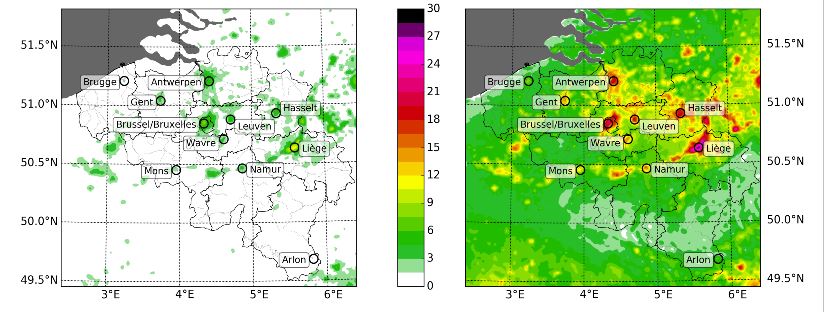7 September 2017
Heat stress escalates in cities under global warming
Posted by larryohanlon
By Larry O’Hanlon
Heatwaves are intensifying in cities due to the double whammy of the urban heat island effect and global warming, according to a new study.
The study’s authors used computer models to simulate with unprecedented detail the temperature changes through the mid-21st century in Belgian cities. They found that heatwaves become hotter, longer and more frequent because of greenhouse gas emissions, and that temperature above the heat stress alarm level increases by a factor of between 1.4 and 15 by the middle of this century.
“The trends are very harmful to an increasing share of people living in the cities, since hot temperatures lead to excessive mortalities, hospital admissions, energy usage and economic loss, which are exacerbated by the urban heat island,” said Hendrik Wouters, of Belgium’s Katholieke Universiteit Leuven and Ghent University.
More deaths from future heat waves could make heat waves the most deadly type of natural disaster in the near future, he added. Wouters is the lead author of the study which appears in Geophysical Research Letters, a publication of the American Geophysical Union.
The urban heat island effect is caused largely by solar energy being converted into heat by stone and concrete in buildings and pavement. At the same time, cities lack cooling provided by vegetation and water, and more heat is generated by human activities and technology.
The urban heat island is felt the most at night, with overall temperature differences between cities and the rural surroundings of 1 to 3 degrees Celsius (1.8 and 5.4 degrees Fahrenheit). However, the urban heat island effect becomes even more intense during heat waves with differences between cities and rural areas reaching even 8 to 12 degrees Celsius (14.4 and 21.6 degrees Fahrenheit) .

Annual mean heatwave degree days in Belgium. Historical on the left, and under business-as-usual climate change scenario on right. Not only the number of hot days days, but also the heatwave intensity are rising drastically under global warming, especially in the cities.
Urban cores like Brussels already experience on average five hot days per year with an average intensity of 3 degrees Celsius(5.4 degrees Fahrenheit) above Belgian temperature alarm levels. The temperatures in Brussels already surpass temperatures in rural areas, where there are only two heat wave days per year, on average, with an excess temperature of less than 1 degree Celsius (1.8 degrees Fahrenheit).
By the middle of this century, cities may experience more than 17 heat wave days per year, on average, with an even greater intensity of 4 degrees Celsius (7.2 degrees Fahrenheit), said Wouters. The worst-case scenario could be 40 hot days per year with an intensity of more than 6 degrees Celsius (10.8 degrees Fahrenheit) of excess heat, according to the new study.
“Even though the future heat stress in rural areas with seven hot days…is lower than in the cities, it is still higher than the urban hot spots of today,” said Wouters. “The outcomes are worrisome, but they also tell us that a lot is possible by the local societies for making our cities sustainable and resistant against global warming.”
Urban warming can be reduced by cutting down cities’ carbon footprints, implemening the Paris Climate Agreement, and also by rolling back urban expansion and avoiding local heat generation, Wouters said. This can be done by fitting low-carbon high-rise buildings, green spaces and vehicle-restricted traffic into existing cities and villages, making them more compact and energy-efficient. Urban hot spots can further become more heat resistant with small streets, shady trees, sunshades and green roofs, running water, fountains, spray systems and storm-water reservoirs, and better thermal regulation of buildings, he said.
“One may otherwise think of migrating to the cooler outlands, but such a strategy would only relocate and even aggravate climate change and its adverse consequences,” said Wouter. “The many existing initiatives demonstrate that the solutions against urban heat lie within our grasp.”
Wouter and his colleagues are looking to interdisciplinary research to find the best approaches to future urbanization. Ideally, any future measures should enhance the cities’ health, quality of living, working and recreation, but also reduce the energy costs under climate change, he said.
— Larry O’Hanlon is a freelance science writer, editor and social media manager in New Mexico. He manages the AGU blogosphere. Follow him on Twitter at @Earth2larryo


 GeoSpace is a blog on Earth and space science, managed by AGU’s Public Information staff. The blog features posts by AGU writers and guest contributors on all sorts of relevant science topics, but with a focus on new research and geo and space sciences-related stories that are currently in the news.
GeoSpace is a blog on Earth and space science, managed by AGU’s Public Information staff. The blog features posts by AGU writers and guest contributors on all sorts of relevant science topics, but with a focus on new research and geo and space sciences-related stories that are currently in the news.